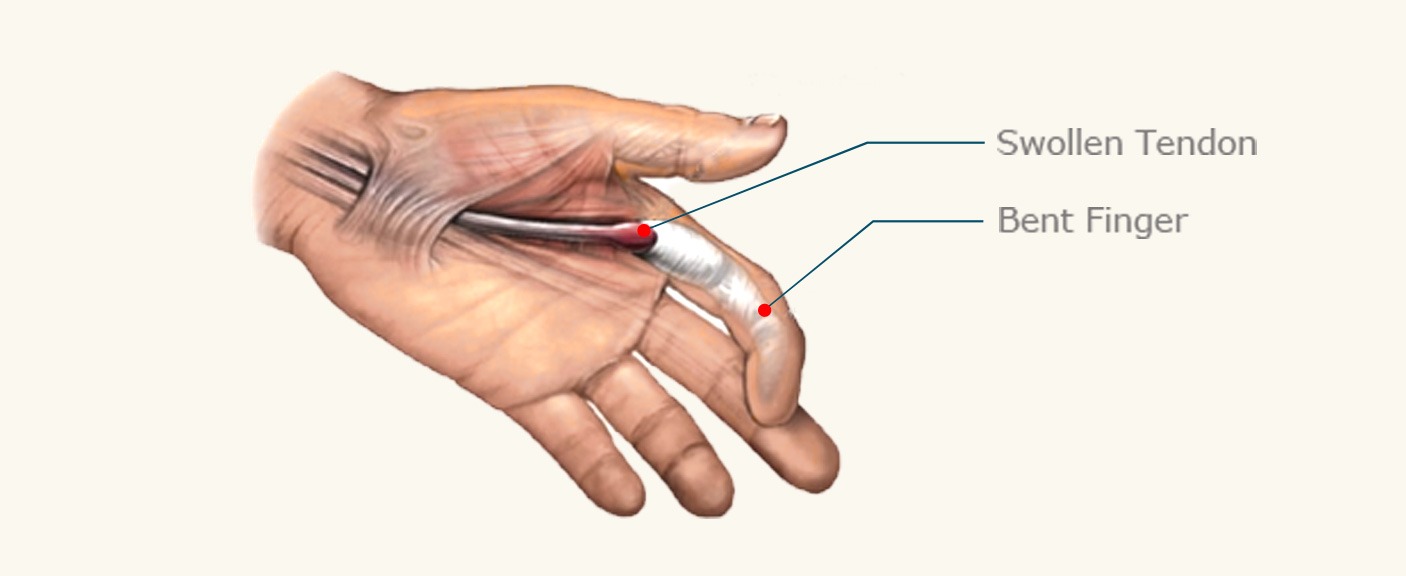- Conditions
- Procedures
- Patient care
- Why choose us
- Our Doctors
- Contact
Stenosing Tenosynovitis (Trigger Finger)

Trigger finger overview
Trigger finger, or stenosing tenosynovitis, is a hand deformity where a finger becomes stuck in a bent position. As the name implies, it can often look like the finger is stuck in the position of pulling a trigger. Although common in the index finger, trigger finger can develop in any finger and is referred to as trigger thumb when it occurs in the thumb.
Untreated trigger finger can become debilitating and interfere with work, hobbies and other activities. Fortunately, this condition is manageable and there are a number of effective treatment options.
If you’re interested in learning more about this condition and potential treatment options, take a moment to review the following information. USA Spine Care is dedicated to patient education and we’ll be glad to answer any questions or help you learn more about our treatment options. Please feel free to reach out at any time.
What causes trigger finger?
Trigger finger is primarily a repetitive motion injury that occurs due to activities that involve frequent bending and unbending of the fingers. It is also believed that stenosing tenosynovitis may be related to conditions such as diabetes and rheumatoid arthritis that cause inflammation in the finger tendons.
Trigger finger develops when the sheaths that protect the tendons and the pulleys that allow the fingers to bend become thick and inflamed. When the finger tries to bend, it can become caught on these inflamed tissues, making it progressively difficult to bend back. Eventually it can become stuck in the bent position.
Signs and symptoms of trigger finger
Trigger finger often starts with mild symptoms that can become more severe over time. This includes:
- Stiff fingers, commonly at the beginning of the day
- Lumps at the base of the finger that gradually become harder
- Catching or popping sensations when bending the finger
- Inability to straighten fingers when bent
- Trouble with motor functions, including pulling with fingers and gripping
Symptoms of trigger finger can worsen over time, so it is highly beneficial to take a proactive approach to seeking diagnosis and treatment if you have experienced any of the above symptoms. Always see a qualified professional for any hand or finger pain that does not improve in a short period of time.
Working with a physician to diagnose trigger finger
Meeting with a physician to diagnose symptoms that may be related to trigger finger should include these steps:
- A review of your medical history and a check for your
- Questions about symptoms and normal activities
- Range of motion testing
- A hands-on examination to detect tenderness or nodules in the palm and fingers
Often diagnostic imagery such as an X-ray or MRI is not required to diagnose trigger finger but it may be useful in ruling out another condition. Coming prepared with as much information as possible about your symptoms, lifestyle and how long you’ve been dealing with finger mobility issues can help speed along the diagnostic and treatment process.
Conservative trigger finger treatment
Once your doctor reaches a diagnosis, treatment for trigger finger generally begins with a course of conservative treatment options.
Therapies that can be effective in helping to manage and relieve trigger finger include:
- Periods of rest, particularly if repetitive motion is believed to be the cause
- Anti-inflammatory steroid injections to lessen inflammation for intermediate periods
- Physical therapy, including gentle stretching and soft tissue mobilization techniques
- Splinting and bracing of the finger
- Over-the-counter medication, particularly nonsteroidal anti-inflammatory drugs
It is important to exercise caution when performing any stretches or exercises in the hand as it has the potential for injuring the fingers.
Trigger finger treatment — surgery
Like many hand conditions, surgery for trigger finger usually only becomes an option if symptoms are severe and not responding to nonsurgical therapies. The goal of trigger finger release surgery, or tenolysis, is primarily to prevent permanent stiffness from developing.
In a trigger finger release surgery, the surgeon will typically enter through a small incision in the wrist and use micro surgical equipment to carefully divide the inflamed pulley in the finger. This should allow the tendon to glide more easily through the protective sheath. This minimally invasive procedure can be performed on an outpatient basis.
Patients are generally encouraged to begin moving their finger immediately, although full recovery typically occurs over a period of weeks and months. After any procedure, the surgical should provide detailed instructions for incision care and a schedule for rehabilitation and resuming normal activities.
Get in touch with the USA Spine Care team to learn more about trigger finger treatment
For information on becoming a candidate for conservative and surgical options to treat hand conditions such as trigger finger, contact USA Spine Care. Our experienced and compassionate staff has decades of experience helping patients get back to the people and activities they’ve been missing and regain quality of life.
Call toll free 1- 866-249-1627
